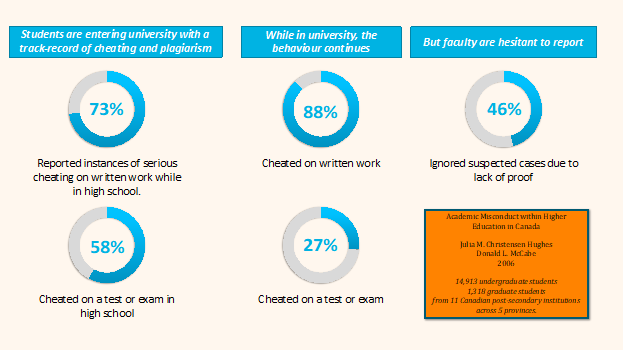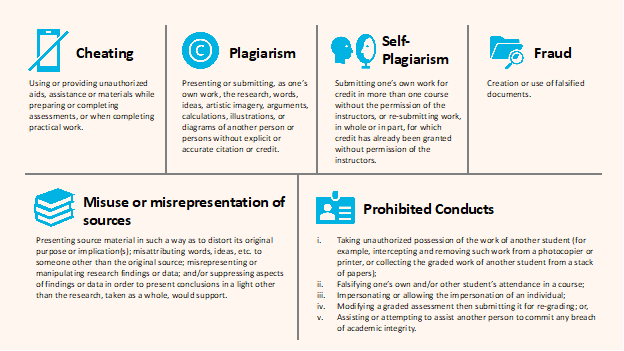Centre for Teaching Excellence
Teach | Academic IntegrityPrevention
Please note that this page has been updated to reflect the Academic Integrity Policy and Procedure effective September 1, 2024.
Academic Integrity is a collective responsibility of the University Community. Instructors are responsible for taking actions to prevent academic dishonesty. The Instructor has responsibility to prevent academic misconduct, as well as to take appropriate action if academic dishonesty has occurred (see Policy S2017-05).
Understanding Academic Integrity
The International Center for Academic Integrity defines academic integrity as a commitment to five fundamental values: honesty, trust, fairness, respect, and responsibility. We believe that these five values, plus the courage to act on them even in the face of adversity, are truly foundational to the academy. Without them, everything that we do in our capacities as teachers, learners, and researchers loses value and becomes suspect.
In the Capilano University policy, academic Integrity means conducting all academic work in an honest and ethical way by:
a) submitting work that demonstrates one’s own words, ideas, voice, writing or creative style;
b) documenting contributions of others, all collaborators, any resources, and aids used;
c) using aids only as authorized by the instructor; and
d) respecting the integrity of examination materials and/or the examination process by
adhering to exam rules and instructions.
Understanding Academic Misconduct
Academic Misconduct in Canada
The latest research study suggests that academic misconduct is widespread at both the high school and university level in Canada.

Forms of Academic Misconduct
The CapU Academic Integrity Policy defines academic misconduct as “any action and behaviour that seeks to gain unfair academic advantage and violates any one of the abovementioned principles of Academic Integrity” (Section 3). The policy lists the most common instances of academic misconduct; however, it is not intended to be exhaustive.

Preventing Academic Misconduct
Minimum requirements
To uphold academic integrity and prevent incidents of academic misconduct, instructors are required to do the following, at minimum:
- Include in all Course Outlines/Syllabi a statement pertaining to the importance of Academic Integrity, and a reference to the Academic Integrity Policy and Procedures for violations to this Policy;
- Review these Course Outlines/Syllabi statements with Students at the beginning of each term and outline expectations for demonstrating Academic Integrity in the course and within the specific academic discipline;
- Provide Students with information about the correct use of acceptable references/citation format(s) within the academic discipline;
- Provide Students with information about any rules relating to acceptable levels of collaboration on assignments or in any required laboratory, research, or clinical work; and
- Provide clear assessment/exam instructions, in writing, that demonstrate expectations of behaviour (i.e. no phone use, closed book, no collaboration, etc.).
Identifying and addressing the underlying issue/s
The most effective way to prevent academic misconduct is to identify possible reasons why its occurring and use strategies that will most likely address the situation. Keep in mind, there may be multiple relevant reasons.
Adapted from: https://www.cmu.edu/teaching/solveproblem/strat-cheating/index.html
Reason #1: Misunderstanding the fundamentals
Student might not understand the fundamentals of plagiarism. Studies show that many students cannot define plagiarism and/or don’t have the skills to cite an idea appropriately. Depending on cultural background, students may not be able to distinguish between providing reasonable help to a classmate and collaborating inappropriately on an assignment and/or may not have experience with paraphrasing.
Strategies
- Define cheating and plagiarism explicitly in your syllabus (see the CapU course outline template).
- Include a link on your course eLearn page for the Writing Centre.
- Include a link on your course eLearn page for the Library Citation Guides.
- Include links to a paraphrasing how-to guide on your course eLearn page, e.g. Purdue
- Explain the significance of this concept and the implications for the workplace
- Require students to complete the Academic Integrity Learning Module on eLearn during the first 2 weeks of your course.
- Require students to complete the APA Practice Tutorial/MLA Practice Tutorial on eLearn during the first 2 weeks of your course.
- Use Turnitin in your course. Allowing students to view their Similarity Report before the assignment due date increases their understanding of plagiarism and provides an opportunity for them to address potential academic misconduct issues.
Reason #2: Perceptions of fairness
Students might perceive tests and/or professors as being unfair. Research suggests that when students perceive exams or tests as unfair (e.g., including material that wasn’t covered in class, skills they haven’t had a chance to practice, questions requiring minute details), they are more likely to cheat.
Strategies
- Assess what is taught – align instruction and assessments
- Communicate the alignment to students, e.g., share the course Evaluation Plan with students
Reason #3: Poor study skills
Some students might cheat because they have poor study skills that prevent them from keeping up with the material. University-level workloads can take some adjustment for students coming from high school or from other cultures. Students may underestimate the time required to complete an assignment or have competing demands on their time (jobs, other courses) so may be desperate enough to consider cheating.
Strategies
- Include a link to CapU’s Learning Support Services on the course eLearn page.
- Use frequent, smaller assignments and tests
- Use classroom assessment techniques to help you and your students gauge their progress
- Discuss the weekly workload required to succeed in the course (e.g. 8 hours = 3 hours of class time, 1 hour for 4th hour activity, 2 hours reading, 2 hours assignments)
Reason #4: The stakes are too high
Students may be more inclined to cheat or plagiarize if the stakes are high or the likelihood of success is perceived to be low. Heavily weighted final exams or papers (accounting for a large portion of the final grade at the end of the course) can create significant pressure on students – there is little room for error and no chance to redeem themselves. In these types of scenarios, students may try cheating rather than studying if they think cheating will provide a better chance of success.
Strategies
- Include a link to CapU’s Learning Support Services on the course eLearn page.
- Use frequent, smaller assignments and tests to give students practice and feedback and several opportunities to earn grades rather than a few high-stake assessments.
- Offer the opportunity to redo an assignment.
Reason #5: Perceived lack of consequences
Students might perceive a lack of consequences for cheating and plagiarizing. Cheating is often dealt with privately to protect a student’s privacy. Other students are not aware that cheating is detected and dealt with, leaving an impression that there are no consequences.
Strategies
- Publicly acknowledge when occurrences of cheating have been detected to your class (in general terms).
- Follow the S2017-05 Academic Integrity Procedure steps to report cheating and plagiarism incidents.
Reason #6: Perception they won't get caught
Students might perceive the possibility to cheat without getting caught.The proliferation of options for cheating (chegg.com, coursehero.com, online test bank shops, generative AI) may lead students to believe that cheating is easy and that they will not get caught.
Strategies
- Require drafts of the work.
- Create unique assignments, e.g. using applied projects.
- Use Turnitin in your course.
- Use testbanks judiciously, e.g., for inspiration, reword questions where possible using examples from classroom discussions or local events
- Explain in advance the cheating-prevention techniques you will be using for in-person exams (allocate seating alphabetically, check ID/sign-in sheet, two proctors in the room, two or more versions of the exam, bags/coats at the front of the room, etc.). It may seem as if you’re giving students notice on how to prepare to cheat which may be the case for a few, but for most students, knowing that there will be measures in place can be enough to reduce the likelihood of cheating.
Reason #7: Student focus may be on grades rather learning
Student focus may be on grades rather than on learning. In this situation, students may be more willing to take a shortcut to achieve the desired grade because they do not perceive the importance of learning.
Strategies:
- Clearly indicate the alignment between the learning objectives and the assessments to students by sharing the course Evaluation Plan.
- Identify the relevance of the learning for future undertakings (e.g., other courses, the workplace, etc.)
Reason #8: Students feel anonymous in class
Students are more likely to cheat when they feel anonymous in class. Students who have a connection to their instructor are less likely to cheat. Students don’t want to let you down. Students who experience anonymity in the classroom are not subject to these social and emotional costs and consequently are more likely to cheat.
Strategies:
- Learn and use students’ names.
- Use pre-class time to meet and greet students.
Reason #9: Unclear instructions or expectations
Students may not understand the criteria for the test/assignment. Unclear instructions and expectations can lead to feelings of frustration and fear of failure that may prompt a student to cheat.
Strategies
- Provide clear instructions in a handout, as part of your syllabus, or on the course eLearn page. Review these instructions in-class explaining the requirements (or provide a video for asynchronous courses).
- Use a rubric to clearly communicate your expectations.
Capilano University is named after Chief Joe Capilano (1854–1910), an important leader of the Skwxwú7mesh (Squamish) Nation of the Coast Salish Peoples. We respectfully acknowledge that our campuses are located on the unceded territories of the səlilwətaɬ (Tsleil-Waututh), shíshálh (Sechelt), Skwxwú7mesh (Squamish), and xʷməθkʷəỷəm (Musqueam) Nations.
Capilano University | 2055 Purcell Way | North Vancouver | BC | Canada | V5J 3H5